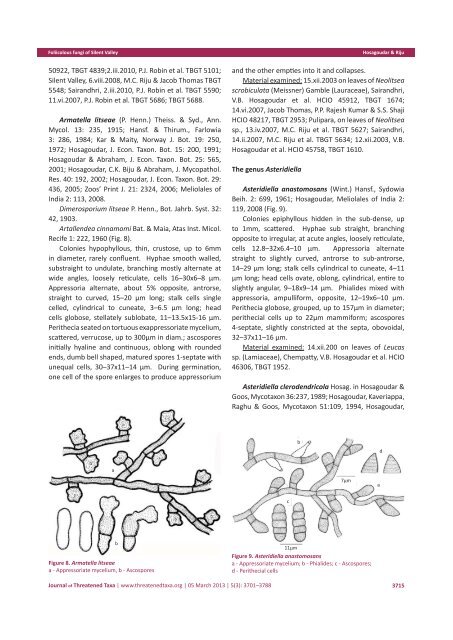Foliicolous fungi <strong>of</strong> Silent ValleyArmatella cryptocaryae Hosag., J. Econ. Taxon. Bot.15: 198, 1991; Hosagoudar et al.., Mycotaxon 56: 350,1995; Hosag., C.K. Biju & T.K. Abraham, J. Econ. Taxon.Bot. 25: 298, 2001; Hosagoudar, J. Econ. Taxon. Bot. 29:436, 2005; Hosagoudar, Zoos’ Print J. 21: 2323, 2006;Meliolales <strong>of</strong> India 2: 108, 2008 (Fig. 6).Colonies epiphyllous, thin, crustose, up to 2mm indiameter. Hyphae smooth walled, straight to substraight,branching alternate to irregular at acute angles, looselyreticulate, cells 12–18.5x4.5–6.5 μm. Appressoriaalternate, antrorse to spreading, 15.5–25 μm long;stalk cells single celled, cylindrical to cuneate, 3–6.5 μmlong; head cells ovoid, conoid, slightly angular, entire,outer wall crenulated, 12–18.5x 9–12.5 μm. Peritheciascattered, seated on exappressoriate mycelium, upto 140μm in diam.; ascospores ellipsoidal, 1-septate,brown, 31–37x12–13 μm.Material examined: 13.xii.2003, on leaves <strong>of</strong> Litseasp. (Lauraceae), Sairandhri, V.B. Hosagoudar et al. HCIO45759, TBGT 1611; HCIO 45774, TBGT 1626; 12.xii.2003,V.B. Hosagoudar et al. TBGT 1973, HCIO 46327; TBGT1991, HCIO 6345; 3793; Silent valley 26.ii.2009, S.S. Shajiet al. HCIO 49551;7.iii.2009, S.S. Shaji et al. HCIO 49567,TBGT 3809; 1.viii.2008, S.S. Shaji et al. HCIO 49798,TBGT 3950;22 July 2009, Jayakumar et al. HCIO 49856,TBGT 4008; 14.ii.2007, M.C. Riju, Gireesh & S.S. ShajiTBGT 5507; Walakad, Silent Valley, 03.iii.2009, S.S. Shajiet al. TBGT 5561; Neelikal, Silent Valley, 06.viii.2008,M.C. Riju et al. TBGT 5576; 2.iii. 2010, P.J. Robin et al.TBGT 5596;2.iii.2010, P.J. Robin et al. TBGT 5600; SilentValley National Park, Kerala, 23.vii.2009, Jayakumar etal. HCIO 50050, TBGT 4202; Sairandhri, Silent Valley,Kerala, 13.xii..2003, V.B. Hosagoudar et al. HCIO 45774,1523; Sairandri, 16.ii.2007, M.C. Riju et al. HCIO 50921,TBGT 4838; Poochipara, 14.ii.2007, M.C. Riju, Gireesh& S.S. Shaji TBGT 5015; Poochipara, 14.ii.2007, M.C.Riju et al. TBGT 5073; Valakadu, 4.iii.2008, P.J. RobinHosagoudar & Rijuet al. TBGT 5103; Sairandhri, 2.viii. 2008, M.C. Rijuet al. TBGT 5230; Poochipara, on leave <strong>of</strong> Persea sp.(Lauraceae), 30.vii.2008, Jacob et al. HCIO 50372, TBGT4289; 26.ii.2009, S.S. Shajiet al. HCIO 49575 TBGT 3817;Wallakked, on leaves <strong>of</strong> Actinodaphne sp. (Lauraceae),1.viii.2008, M.C. Riju et al. HCIO 50375, TBGT 4292; onleave <strong>of</strong> Cryptocarya sp., 14.ii.2007, M.C. Riju & S.S. ShajiTBGT 5505; Sairandhri, on leave <strong>of</strong> Cinnamomum sp.(Lauraceae), 24.iv.2007, S.S. Shaji & Harish TBGT 5537.Armatella katumotoi Hosag., Sydowia 40: 113,1987; J. Econ. Taxon. Bot. 15: 199, 1991; Hosagoudar &Abraham, J. Econ. Taxon. Bot. 25: 564, 2001; Hosagoudar,J. Econ. Taxon. Bot.29: 436, 2005; Hosagoudar, Meliolales<strong>of</strong> India 2: 111, 2008 (Fig. 7).Colonies hypophyllous, thin, scattered, diffused, upto 5mm in diameter. Hyphae smooth walled, flexuousto crooked, branching alternate to irregular at acuteangles, loosely reticulate, cells 15.5–46.5x4.5–6.5 μm.Appressoria alternate, variously curved, 18.5–46.5 μmlong; stalk cells septate to several septate, flexuousto crooked, 6.5–40.5 μm long; head cells ovate toglobose, entire to stellately lobate, 6.5–12.5x12.5–15.5μm. Perithecia scattered, seated on exappressoriatemycelium, verrucose, up to 217μm in diam.; ascosporesbrown, ellipsoidal, 1-septate, 28–31x12–16 μm.Material examined: 13.xii.2003 on leaves <strong>of</strong> Litseasp. (Lauraceae), Sairandhri, V.B. Hosagoudar et al.HCIO 45759, TBGT 1611; HCIO 45774, TBGT 1626;HCIO 45773, TBGT 1625; HCIO 45774, TBGT1523; HCIO45773, TBGT 1522; HCIO 46346, TBGT 1992; HCIO46698, TBGT 2039; HCIO 47680, TBGT 2702; 27.ii.2009,S.S. Shaji et al. HCIO 49545, TBGT 3787; Sairandhri,Silent Valley, Kerala, on leaves <strong>of</strong> Persea sp. (Lauraceae),Silent Valley, 26.ii.2009, S.S. Shaji et al. HCIO 49552,TBGT 3794; 30.vii.2009, Jayakumar et al. HCIO 49864,TBGT 4016; Sairandri, 16.ii.2007, M.C. Riju et al. HCIObabaFigure 6. Armatella cryptocaryaea - Appressoriate mycelium; b - Ascospores3714Figure 7. Armatella katumotoia - Appressoriate mycelium; b - Ascospores<strong>Journal</strong> <strong>of</strong> <strong>Threatened</strong> <strong>Taxa</strong> | www.threatenedtaxa.org | 05 March 2013 | 5(3): 3701–3788
Foliicolous fungi <strong>of</strong> Silent Valley50922, TBGT 4839;2.iii.2010, P.J. Robin et al. TBGT 5101;Silent Valley, 6.viii.2008, M.C. Riju & Jacob Thomas TBGT5548; Sairandhri, 2.iii.2010, P.J. Robin et al. TBGT 5590;11.vi.2007, P.J. Robin et al. TBGT 5686; TBGT 5688.Armatella litseae (P. Henn.) Theiss. & Syd., Ann.Mycol. 13: 235, 1915; Hansf. & Thirum., Farlowia3: 286, 1984; Kar & Maity, Norway J. Bot. 19: 250,1972; Hosagoudar, J. Econ. Taxon. Bot. 15: 200, 1991;Hosagoudar & Abraham, J. Econ. Taxon. Bot. 25: 565,2001; Hosagoudar, C.K. Biju & Abraham, J. Mycopathol.Res. 40: 192, 2002; Hosagoudar, J. Econ. Taxon. Bot. 29:436, 2005; Zoos’ Print J. 21: 2324, 2006; Meliolales <strong>of</strong>India 2: 113, 2008.Dimerosporium litseae P. Henn., Bot. Jahrb. Syst. 32:42, 1903.Artallendea cinnamomi Bat. & Maia, Atas Inst. Micol.Recife 1: 222, 1960 (Fig. 8).Colonies hypophyllous, thin, crustose, up to 6mmin diameter, rarely confluent. Hyphae smooth walled,substraight to undulate, branching mostly alternate atwide angles, loosely reticulate, cells 16–30x6–8 μm.Appressoria alternate, about 5% opposite, antrorse,straight to curved, 15–20 μm long; stalk cells singlecelled, cylindrical to cuneate, 3–6.5 μm long; headcells globose, stellately sublobate, 11–13.5x15-16 μm.Perithecia seated on tortuous exappressoriate mycelium,scattered, verrucose, up to 300μm in diam.; ascosporesinitially hyaline and continuous, oblong with roundedends, dumb bell shaped, matured spores 1-septate withunequal cells, 30–37x11–14 μm. During germination,one cell <strong>of</strong> the spore enlarges to produce appressoriumHosagoudar & Rijuand the other empties into it and collapses.Material examined: 15.xii.2003 on leaves <strong>of</strong> Neolitseascrobiculata (Meissner) Gamble (Lauraceae), Sairandhri,V.B. Hosagoudar et al. HCIO 45912, TBGT 1674;14.vi.2007, Jacob Thomas, P.P. Rajesh Kumar & S.S. ShajiHCIO 48217, TBGT 2953; Pulipara, on leaves <strong>of</strong> Neolitseasp., 13.iv.2007, M.C. Riju et al. TBGT 5627; Sairandhri,14.ii.2007, M.C. Riju et al. TBGT 5634; 12.xii.2003, V.B.Hosagoudar et al. HCIO 45758, TBGT 1610.The genus AsteridiellaAsteridiella anastomosans (Wint.) Hansf., SydowiaBeih. 2: 699, 1961; Hosagoudar, Meliolales <strong>of</strong> India 2:119, 2008 (Fig. 9).Colonies epiphyllous hidden in the sub-dense, upto 1mm, scattered. Hyphae sub straight, branchingopposite to irregular, at acute angles, loosely reticulate,cells 12.8–32x6.4–10 μm. Appressoria alternatestraight to slightly curved, antrorse to sub-antrorse,14–29 μm long; stalk cells cylindrical to cuneate, 4–11μm long; head cells ovate, oblong, cylindrical, entire toslightly angular, 9–18x9–14 μm. Phialides mixed withappressoria, ampulliform, opposite, 12–19x6–10 μm.Perithecia globose, grouped, up to 157μm in diameter;perithecial cells up to 22μm mammiform; ascospores4-septate, slightly constricted at the septa, obovoidal,32–37x11–16 μm.Material examined: 14.xii.200 on leaves <strong>of</strong> Leucassp. (Lamiaceae), Chempatty, V.B. Hosagoudar et al. HCIO46306, TBGT 1952.Asteridiella clerodendricola Hosag. in Hosagoudar &Goos, Mycotaxon 36:237, 1989; Hosagoudar, Kaveriappa,Raghu & Goos, Mycotaxon 51:109, 1994, Hosagoudar,bda7µmacFigure 8. Armatella litseaea - Appressoriate mycelium, b - Ascosporesb11µmFigure 9. Asteridiella anastomosansa - Appressoriate mycelium; b - Phialides; c - Ascospores;d - Perithecial cells<strong>Journal</strong> <strong>of</strong> <strong>Threatened</strong> <strong>Taxa</strong> | www.threatenedtaxa.org | 05 March 2013 | 5(3): 3701–37883715

















